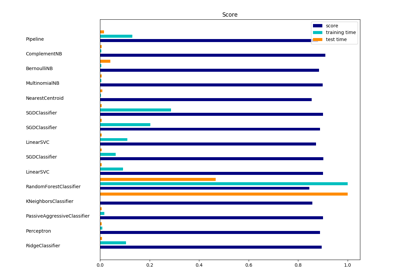sklearn.feature_selection.SelectKBest¶
-
class
sklearn.feature_selection.SelectKBest(score_func=<function f_classif>, k=10)[source]¶ Select features according to the k highest scores.
Read more in the User Guide.
Parameters: - score_func : callable
Function taking two arrays X and y, and returning a pair of arrays (scores, pvalues) or a single array with scores. Default is f_classif (see below “See also”). The default function only works with classification tasks.
- k : int or “all”, optional, default=10
Number of top features to select. The “all” option bypasses selection, for use in a parameter search.
Attributes: - scores_ : array-like, shape=(n_features,)
Scores of features.
- pvalues_ : array-like, shape=(n_features,)
p-values of feature scores, None if score_func returned only scores.
See also
f_classif- ANOVA F-value between label/feature for classification tasks.
mutual_info_classif- Mutual information for a discrete target.
chi2- Chi-squared stats of non-negative features for classification tasks.
f_regression- F-value between label/feature for regression tasks.
mutual_info_regression- Mutual information for a continuous target.
SelectPercentile- Select features based on percentile of the highest scores.
SelectFpr- Select features based on a false positive rate test.
SelectFdr- Select features based on an estimated false discovery rate.
SelectFwe- Select features based on family-wise error rate.
GenericUnivariateSelect- Univariate feature selector with configurable mode.
Notes
Ties between features with equal scores will be broken in an unspecified way.
Examples
>>> from sklearn.datasets import load_digits >>> from sklearn.feature_selection import SelectKBest, chi2 >>> X, y = load_digits(return_X_y=True) >>> X.shape (1797, 64) >>> X_new = SelectKBest(chi2, k=20).fit_transform(X, y) >>> X_new.shape (1797, 20)
Methods
fit(X, y)Run score function on (X, y) and get the appropriate features. fit_transform(X[, y])Fit to data, then transform it. get_params([deep])Get parameters for this estimator. get_support([indices])Get a mask, or integer index, of the features selected inverse_transform(X)Reverse the transformation operation set_params(**params)Set the parameters of this estimator. transform(X)Reduce X to the selected features. -
__init__(score_func=<function f_classif>, k=10)[source]¶ Initialize self. See help(type(self)) for accurate signature.
-
fit(X, y)[source]¶ Run score function on (X, y) and get the appropriate features.
Parameters: - X : array-like, shape = [n_samples, n_features]
The training input samples.
- y : array-like, shape = [n_samples]
The target values (class labels in classification, real numbers in regression).
Returns: - self : object
-
fit_transform(X, y=None, **fit_params)[source]¶ Fit to data, then transform it.
Fits transformer to X and y with optional parameters fit_params and returns a transformed version of X.
Parameters: - X : numpy array of shape [n_samples, n_features]
Training set.
- y : numpy array of shape [n_samples]
Target values.
Returns: - X_new : numpy array of shape [n_samples, n_features_new]
Transformed array.
-
get_params(deep=True)[source]¶ Get parameters for this estimator.
Parameters: - deep : boolean, optional
If True, will return the parameters for this estimator and contained subobjects that are estimators.
Returns: - params : mapping of string to any
Parameter names mapped to their values.
-
get_support(indices=False)[source]¶ Get a mask, or integer index, of the features selected
Parameters: - indices : boolean (default False)
If True, the return value will be an array of integers, rather than a boolean mask.
Returns: - support : array
An index that selects the retained features from a feature vector. If indices is False, this is a boolean array of shape [# input features], in which an element is True iff its corresponding feature is selected for retention. If indices is True, this is an integer array of shape [# output features] whose values are indices into the input feature vector.
-
inverse_transform(X)[source]¶ Reverse the transformation operation
Parameters: - X : array of shape [n_samples, n_selected_features]
The input samples.
Returns: - X_r : array of shape [n_samples, n_original_features]
X with columns of zeros inserted where features would have been removed by transform.
-
set_params(**params)[source]¶ Set the parameters of this estimator.
The method works on simple estimators as well as on nested objects (such as pipelines). The latter have parameters of the form
<component>__<parameter>so that it’s possible to update each component of a nested object.Returns: - self





